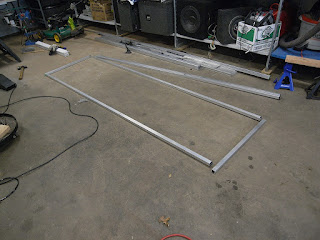Now that the shop is mostly taken care of, I can get back to actually making progress on projects!
I had to cut two more pieces of 2" wide plate as braces for the sign frame:
Those pieces started out as one piece of 4"x8'x3/16" plate. I cut the plate to the length I needed ( 26 1/2") and then cut it down the middle with my bandsaw. It took a while, but with good layout and a steady hand, I am impressed with how nicely the ended up being.
Then it was time for some grinding. As and welder who prides themselves on making good looking and strong welds, it hurts a bit when you have to grind the welds down for aesthetic or, in this case, functionality. Here is what I had to do:
Since the T-shaped piece is going to have the sign frame support tubes swing around it, the welds had to be ground flush so that the side plates would clear.
Now I am showing off why I prefer to have good clamping areas on all work benches:
It just makes your life so much easier to have a solid place to clamp what you are working on down so you can not worry about holding things. Solid clamping makes for a much safer work environment.
After grinding down the welds, I center punched the previously marked spots for the pivot and locking holes:
This is the tool I use for all my center punching:
Even though it is a Starrett, it is extremely reasonably priced. The tips are replaceable, though I haven't had to replace the original in the . . . 3 or so years I've been using it, marking many thousands of holes to be drilled. You can also adjust the tension which effects the effort and punch depth. I love it. If you want to make your layout and drilling much more precise, get an automatic center punch! It is very much worth it.
Once I got the holes marked, it is time to drill. Now here is a not about drill press safety:
If you don't have a piece that is long enough to rest against the upright of your drill press, put a stop on the dang work table. As you can see above, it is nothing fancy, but it is necessary! You can severely injure yourself, or, more importantly, ruin the piece you are drilling if it slips from your hands as you are drilling. The worst time for it to slip is when the bit is about to break through, as this is when the bit is most likely to grab the piece and spin it, breaking the bit, your hands/fingers/workpiece.
I finished drilling the pilot holes after being annoyed that my baby sized drill press didn't have enough stroke to drill all the way through the sides of the 2" box tube. I had to mark the other side of the tube and go through the whole process again. *le sigh*
Anyway, I finished getting the holes drilled and then cut the tube supports to the general length needed:
I had to file down the insides of the tube so that the supports would be able to fit around the hole:
I finished the supports to length on my sander, then tapped them into place:
The reason why I am bothering with this is that the support Ts are going to be the most stressed member of this whole construction. Adding in the tube to couple the sides together will greatly increase torsional rigidity which will help cope with with loads from the large vinyl sign.
The next task was to start drilling out holes on the sign frame supports:
This is where my drill press decided to stop working. Again. I am pretty stumped as to why, but I will figure it out or get another one as soon as I have the cash in hand to do it.
Always support your work! I would never have been able to pop 1/2" holes in the thin support plates had I not been clever and used the Ts to support the ends of the plates:
This is the assembly bolted together:
Do note that I will have to trim the corner of the T and also the corner of the plates in order to clear everything when the entire assembly swings. I left them square to make it easier to work on everything, but will make the final cuts when I know everything else fits as perfectly as posible.





















































